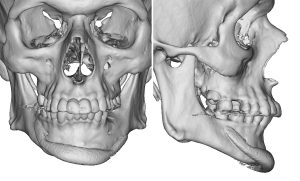Chin augmentation is one of the best values in facial surgery because it is both simple and tremendously effective for many patients. Changing the projection of the chin affects one’s profile and balance of facial proportions Because of its relative simplicity, it is widely performed by cosmetic surgeons at all levels of experience and training. It is the chin implant’s apparent simplicity, however, that can led to surgical mishaps and unhappy patients. Surgeons often offer chin implants as a relatively minor procedure, offering them as part of a rhinoplasty or facelift.
A chin implant is essentially a space-occupying mass that pushes out the overlying soft tissue. Within this soft tissue envelope lies the mentalis muscle, which must not only have one end lifted off the bone to insert the implant but will also end up stretching out the muscle as well. While some chin implant problems are related to the position or size of the implant, the most troublesome ones to correct are the result of what has happened to the overlying soft tissues.
One of the most common causes of chin implant problems is when an intraoral approach is used. Disrupting the upper attachment of the mentalis muscle can be risky. If the muscle is not properly put back of during closure, the muscle will contract and pull the chin soft tissues downward. (chin ptosis) If there is sufficient contraction, the lower lip will be pulled down and excess lower teeth will show. It only takes but a few millimeters of downward lip movement for patients to notice. Correction of chin pad ptosis requires re-entering through mouth, freeing up of the muscle, and re-suspension back up on the bone. Or when an indwelling implant, back up over it and secured to the bone. The whole corrective operation depends on the method of securing it to the bone. I have successfully used both small metal screws and resorbable bone anchors. The bone anchors are the easiest to use and two or three of them work quite nicely.

Chin implant removal invariably causes soft tissue problems. In addition to inducing chin pad ptosis, the pocket where the implant used to reside can contract or even fill with fluid, leading to subsequent visible deformities and irregularities of the skin of the chin. To ideally avoid these difficult problems, consider replacing the implant with a smaller one (so the space does not completely collapse) or an advancement osteotomy. If one is possessed about having no implant or considerably less chin projection, one should consider doing a submental tuck-up from below where the expanded soft tissues can be reduced and tightened.

Dr. Barry Eppley
Indianapolis Indiana


